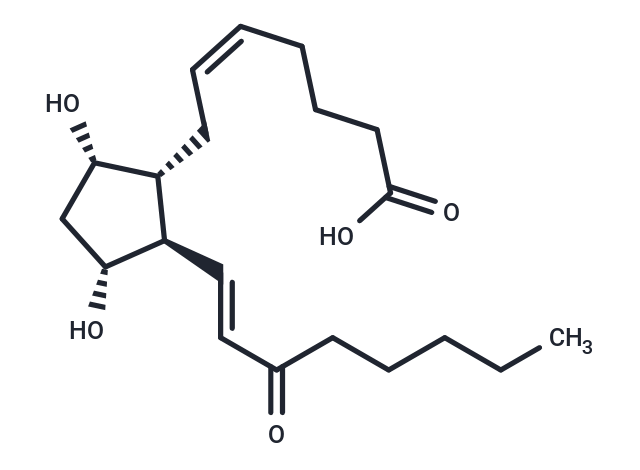Shopping Cart
- Remove All
 Your shopping cart is currently empty
Your shopping cart is currently empty

15-keto Prostaglandin F2α is a metabolite of Prostaglandin F2α that lowers intraocular pressure in rabbits.

| Pack Size | Price | Availability | Quantity |
|---|---|---|---|
| 1 mg | $498 | 35 days |
| Description | 15-keto Prostaglandin F2α is a metabolite of Prostaglandin F2α that lowers intraocular pressure in rabbits. |
| In vivo | 15-keto Prostaglandin F2α stimulates the male goldfish and salmon olfactory receptors with detection thresholds of 10-12 and 10-8 M, respectively.[1] [2] 15-keto Prostaglandin F2α is 10-fold less active than PGF2α in decreasing rabbit intraocular pressure.[3] |
| Alias | 15-keto Prostaglandin F2α, 15-keto PGF2α |
| Molecular Weight | 352.47 |
| Formula | C20H32O5 |
| Cas No. | 35850-13-6 |
| Smiles | C(/C=C\CCCC(O)=O)[C@@H]1[C@@H](/C=C/C(CCCCC)=O)[C@H](O)C[C@@H]1O |
| Relative Density. | 1.149 g/cm3 (Predicted) |
| Storage | store at low temperature | Powder: -20°C for 3 years | In solvent: -80°C for 1 year | Shipping with blue ice. | |||||||||||||||||||||||||||||||||||
| Solubility Information | DMF: 100 mg/mL (283.71 mM), Sonication is recommended. Ethanol: 100 mg/mL (283.71 mM), Sonication is recommended. DMSO: 100 mg/mL (283.71 mM), Sonication is recommended. | |||||||||||||||||||||||||||||||||||
Solution Preparation Table | ||||||||||||||||||||||||||||||||||||
DMF/Ethanol/DMSO
| ||||||||||||||||||||||||||||||||||||

Copyright © 2015-2025 TargetMol Chemicals Inc. All Rights Reserved.